Cryptocurrency markets are taking hits from all sides – from declines in value to multiple corporate bankruptcies to lawsuits and regulatory threats. Among the vast majority of Americans who say they have heard at least a little about cryptocurrency (88%), three-quarters say they are not confident that current ways to invest in, trade or use cryptocurrencies are reliable and safe, according to a Pew Research Center survey conducted March 13-19. This comes out to about two-thirds of all U.S. adults.
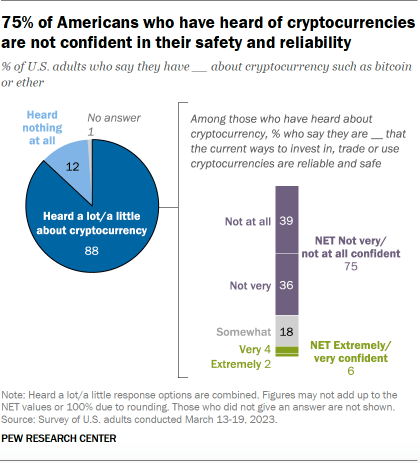
Roughly four-in-ten adults who have heard about cryptocurrency (39%) say they are not at all confident and an additional 36% are not very confident in the reliability and safety of cryptocurrencies. On the other end of the spectrum, few of these adults are extremely (2%) or very (4%) confident in cryptocurrencies. About one-in-five (18%) say they are somewhat confident.
While concern about cryptocurrency is broad, some groups of Americans are more concerned than others. For instance, adults ages 50 and older who have heard about cryptocurrency are more likely than their younger counterparts to say they are not confident in its reliability and safety (85% vs. 66%).
Pew Research Center conducted this study to examine Americans’ views of and personal experiences with cryptocurrency. This survey was conducted among 10,701 U.S. adults from March 13-19, 2023. Everyone who took part is a member of Pew Research Center’s American Trends Panel (ATP), an online survey panel that is recruited through national, random sampling of residential addresses. This way, nearly all U.S. adults have a chance of selection. The survey is weighted to be representative of the U.S. adult population by gender, race, ethnicity, partisan affiliation, education and other categories. Read more about the ATP’s methodology. Here are the questions used for this analysis, along with responses, and its methodology.
This survey includes a total sample size of 375 Asian adults. The sample primarily includes English-speaking Asian Americans and therefore may not be representative of the overall Asian adult population. Despite this limitation, Asian adults’ responses are incorporated into the general population figures throughout this report.
Women are also slightly more skeptical of investing in, trading or using cryptocurrencies. Among Americans who have heard about cryptocurrency, 80% of women say they are not confident in it, compared with 71% of men.
Attitudes also differ based on whether someone has invested in cryptocurrency. While one-in-five cryptocurrency users say they are extremely or very confident that it is safe and reliable, that share drops to 2% among those who are familiar with cryptocurrency but have not invested. Still, many who have invested in cryptocurrency also have concerns about its security: 43% of this group say they are not very or not at all confident in it.
Who uses cryptocurrency in the U.S.?
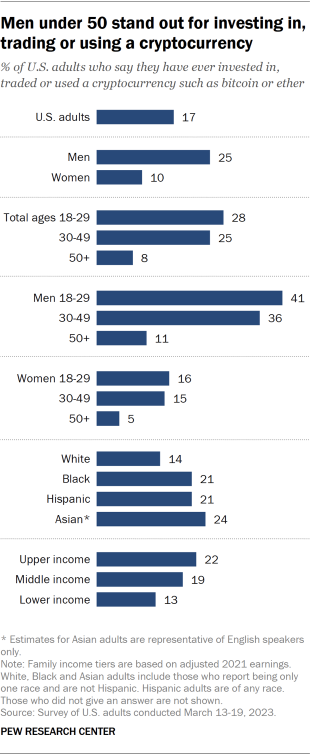
Overall, 17% of U.S. adults say they have ever invested in, traded or used a cryptocurrency. This share is mostly unchanged from previous Center surveys conducted in 2021 and 2022.
As was true in past surveys, younger men are more likely to use cryptocurrency compared with men 50 and older and women of any age. For example, 41% of men ages 18 to 29 say they have ever invested in, traded or used cryptocurrency, compared with 16% of women in the same age range.
Cryptocurrency use also differs by race, ethnicity and income level. Some 24% of Asian adults and 21% of Black or Hispanic adults say they have ever invested in or used a cryptocurrency, compared with 14% of White adults.
About one-in-five adults with upper (22%) or middle (19%) incomes have ever invested in, traded or used cryptocurrency, compared with 13% of those with lower incomes.
Few cryptocurrency users first used it within the past year
The survey also asked Americans when they first used cryptocurrency. Roughly three-quarters of those who have ever invested in, traded or used cryptocurrency (74%) say they did so for the first time one to five years ago. Much smaller shares say they first did this within the past year (16%) or more than five years ago (10%).
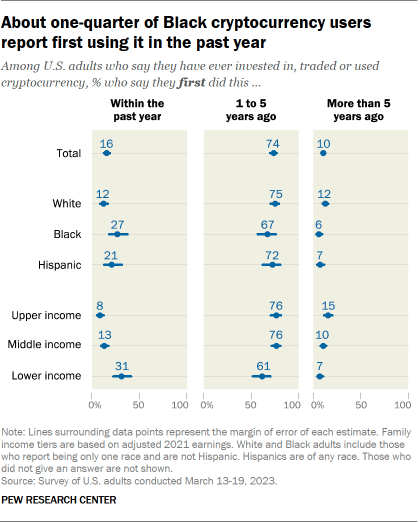
There are differences by race, ethnicity and household income among newer cryptocurrency investors. Black users (27%) are more likely than White users (12%) to say they first used cryptocurrency within the past year. Roughly two-in-ten Hispanic users (21%) say the same. (There were not enough Asian American cryptocurrency users to be broken out into a separate analysis.) And about three-in-ten users from lower-income households report first investing in cryptocurrency within the past year, compared with about one-in-ten adults from middle- or upper-income households.
Some past cryptocurrency users no longer have it today
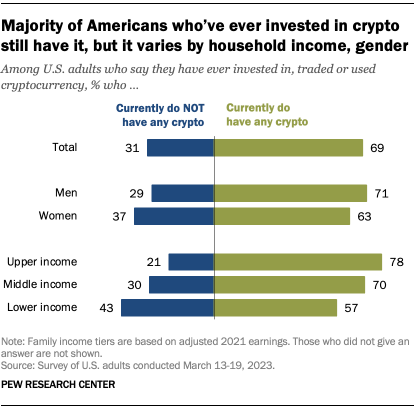
Roughly three-in-ten adults (31%) who have ever invested in, traded or used cryptocurrency say they currently do not have any cryptocurrency. Still, a majority (69%) say they do currently have cryptocurrency.
Those who live in lower-income households (43%) are more likely than those in middle- (30%) or upper-income (21%) households to have given up cryptocurrency. And women who have ever used cryptocurrency are more likely than men in this same group to say they currently do not have any of the currency (37% vs. 29%).
Roughly one-in-five cryptocurrency users say the investments have hurt their personal finances at least a little
A plurality of cryptocurrency users (45%) report that their investments have performed worse than they expected, a result that is statistically unchanged since July 2022, when the Center last asked about this. In comparison, 15% say their investments have done better than expected, 32% say they have done about the same as expected and 7% are unsure.
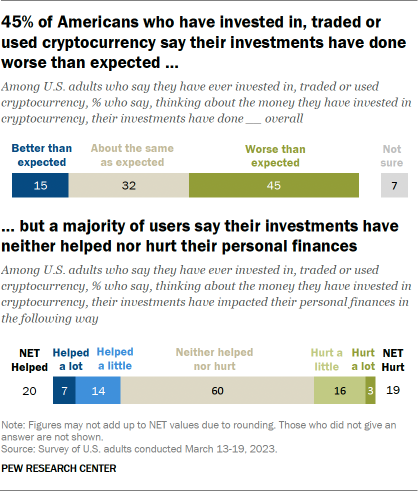
However, when it comes to the impact these investments have had on users’ personal finances, three-in-five users (60%) say that they have neither helped nor hurt. Roughly equal shares say that these investments have helped (20%) or hurt (19%) their finances. Just 7% say that cryptocurrency has helped their finances a lot and 3% say that it has hurt a lot.
College graduates (25%) and those with some college experience (20%) are more likely than those with a high school education or less (10%) to say that their cryptocurrency investments hurt their personal finances.
Note: Here are the questions used for this analysis, along with responses, and its methodology.

